Brick Engineering: Planetary Gear Trains
This week is Engineers’ Week, and as part of that celebration, today we are going to dive into planetary gear trains!
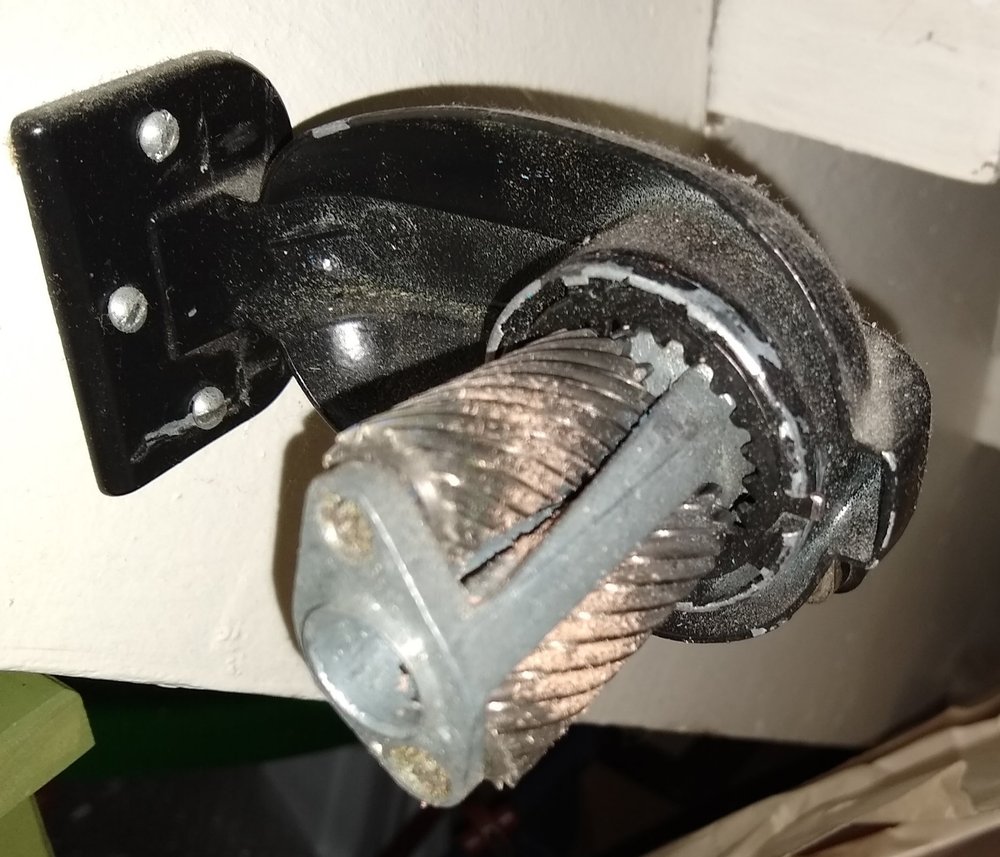
Ring and Planets in a pencil sharpener
These gear trains have some unique features that may make interesting additions to your builds. Planetary Gear Trains (from now on PGTs) are used in lots of things: cars, helicopters, airplanes, wind turbines, electric drills, and manual pencil sharpeners to make a shortlist.
A big advantages is that they have coaxial input/output shafts, can often take up less space than other transmissions, have less torque loss, and better distributes the load among the gears. In our LEGO PGTs, we likely won’t see much space-saving, but we should get the rest of those advantages. So let’s get nerdy and explore planetary gear trains in LEGO!
The Basics
[If math scares you, skip to the next section where we start talking about LEGO!] PGTs have three major components: the Sun Gear, the Ring Gear, and the Planet Carrier/Planet Gear assembly. Below are cross-sectional (left) and top (right) views of a PGT. Notice that it is not the planet gears that have the output but the planet carrier. The planet gears are like idler gears in other gear trains but their orbital motion between ring and sun can be made useful.
View fullsize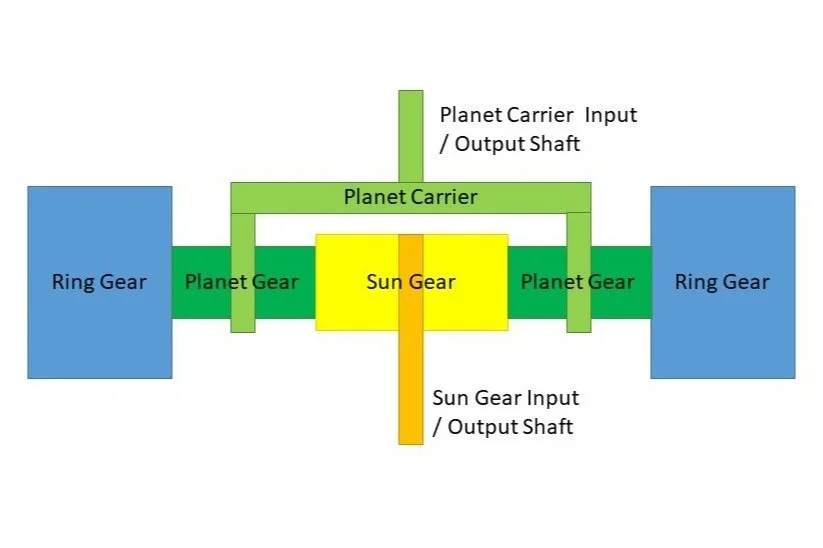
View fullsize
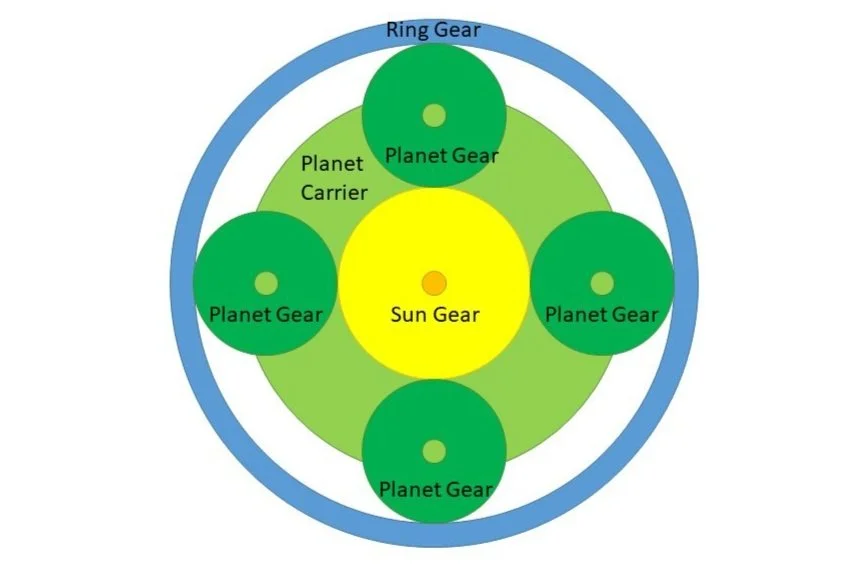
A unique feature of PGTs is that it has three potential gear ratios! Any one of the three major components can be held fixed with the other two being used as input and output. With two gears, we simply divide the number of teeth on the driven gear (power out) by the number of teeth on the driving gear (power in). For planetary gear trains, the procedures differ depending on what component you hold fixed:
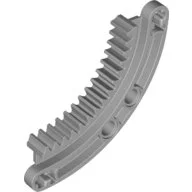
First, the number of teeth on the ring gear is added to the number of teeth on the sun gear. For example, part 78442 when combined into a ring gear has 60 teeth. So, one of the combinations that works with LEGO 20 tooth double bevel gear is
60 teeth + 20 teeth = 80 teeth
For Carrier as input, Ring gear as output, and Sun gear fixed
Ring is driven, and carrier is driving the gear ratio is
60 teeth / 80 teeth = 0.75 or a ratio of 3:4
For Carrier as output, Ring gear fixed, and Sun gear as input
Carrier is driven, and Sun is driving the gear ratio is
80 teeth / 20 teeth = 4 or a ratio of 4:1
For Carrier fixed, Ring gear as input, and Sun gear as output
Sun is driven, and Ring is driving the gear ratio is
20 teeth / 60 teeth = 0.33 or a ratio of 1:3
You can flip the above fractions if the input/outputs are switched. Here is a quick video that illustrates some of these ratios visually using 3D-printed parts.
So now, I know you all have absorbed those ratios, so let’s take a look at them made out of LEGO.
Exploration in the Bricks
Now that we have a basic understanding of PGTs, let’s talk LEGO! Until recently building a planetary gearbox out of LEGO wasn’t practical. With the introduction of the 6x6 quarter circle gear racks found in the new Star Wars UCS AT-AT set, we finally have LEGO parts that will work as ring gears! While the 11x11 quarter-circle gear racks (design IDs 24121 and 43038) and the HailFire Droid gear/wheel are ring gears, their large diameters make them impractical.
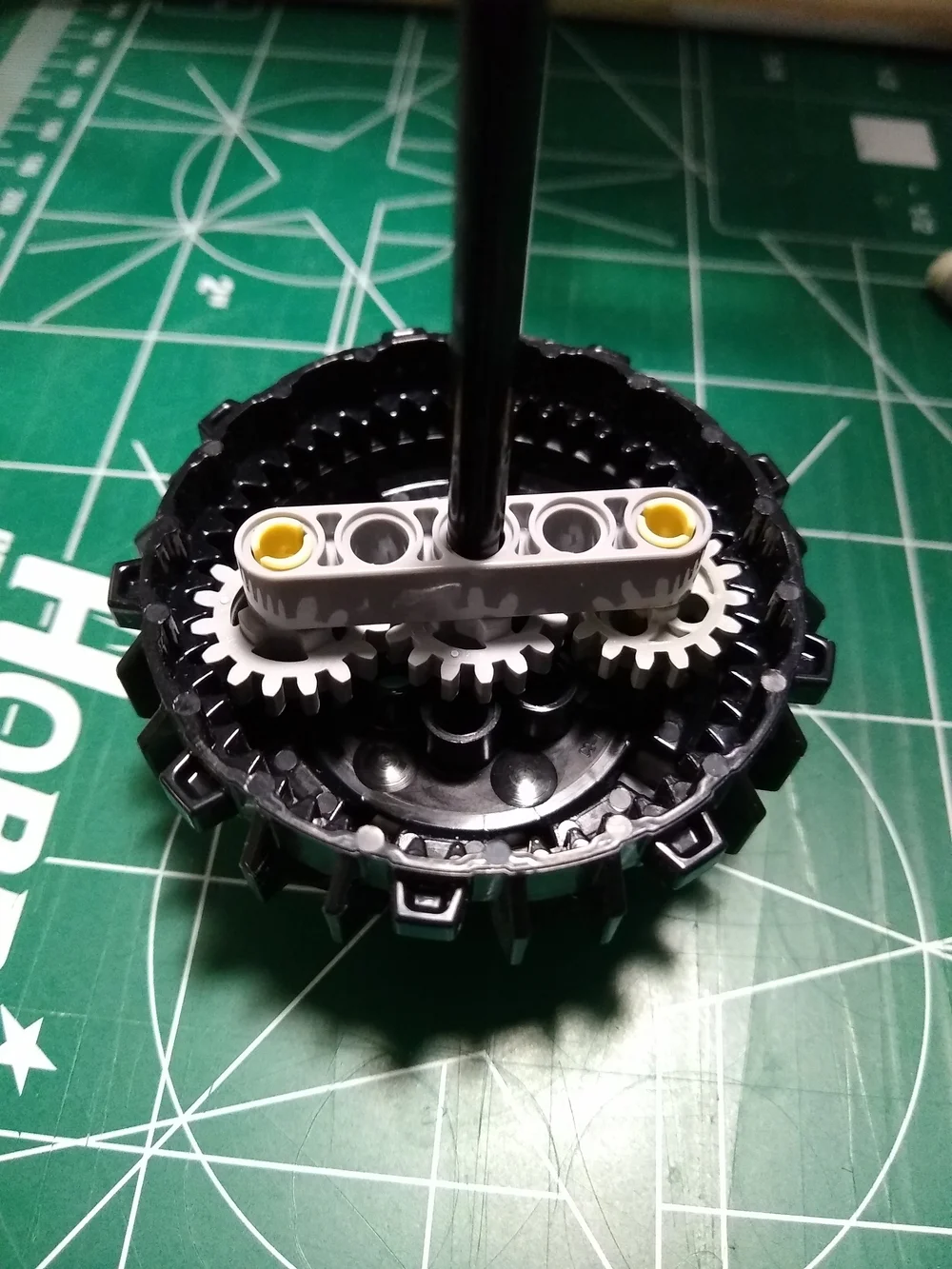
16 toothed gears fit across part 64712. Due to the lip on the ring gear, beveled gears do not mesh well.
FlagsNZ over at Brickset shows how large the full ring is compared to inner gears in this great article from 2016. It was possible to use part 64712, but it was difficult to mount anything to it. I had built two, and they lived on my workbench for a while but no longer exist. I currently can’t figure out the second arrangement, but the start of a PGT using 16 toothed gears is pictured here. LEGO has had a couple of PGT-like assemblies in sets but they lacked the ring gear such as in set 70168 Drillex Diamond Job.
The first step was to determine what size gears would fit in the ring gear made by four of the grew quarter-circle gears (part 78442). I started with all the classic straight-toothed gears: 8, 16, 24, and 40-toothed, but none fit. So I moved on to the double-beveled gears and two options fit! One option was using 20 toothed gears as sun and planets and using the 36 toothed gear as the sun and 12 toothed gears as planets. I had hopes for the 28 toothed small turntable and the 16 toothed gear as that could make for a very compact assembly in height but it was just barely too small, and using 14 tooth gears didn’t work either. Darn!

A ring of four 78442 with 36 toothed Sun Gear and eight 12 toothed Planet Gears

A ring of four 78442 with 20 toothed Sun Gear and four 20 toothed Planet Gears of different flavors!
The Builds
36/12
Now onto the construction of the LEGO planetary gear train. I’ll detail the 36/12 toothed system first as it should be the easier build. I have a limited supply of Technic so there very well may be a better solution, fair warning.

Planet carrier arms and gears
If you chose my design or come up with your own, the key to the planet carrier is the gears freely rotate and the planet carrier shaft is locked so it rotates with the planet carrier.
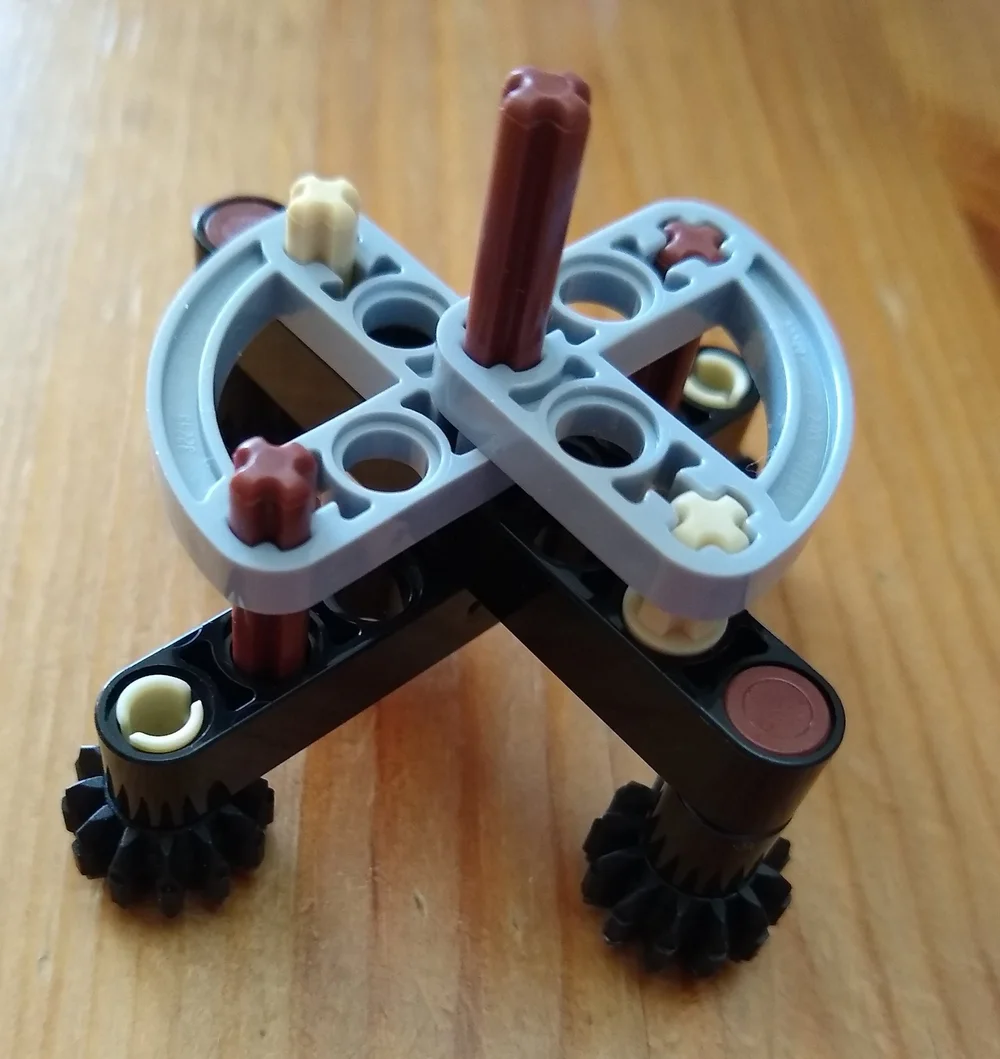
Planet carrier full assembly
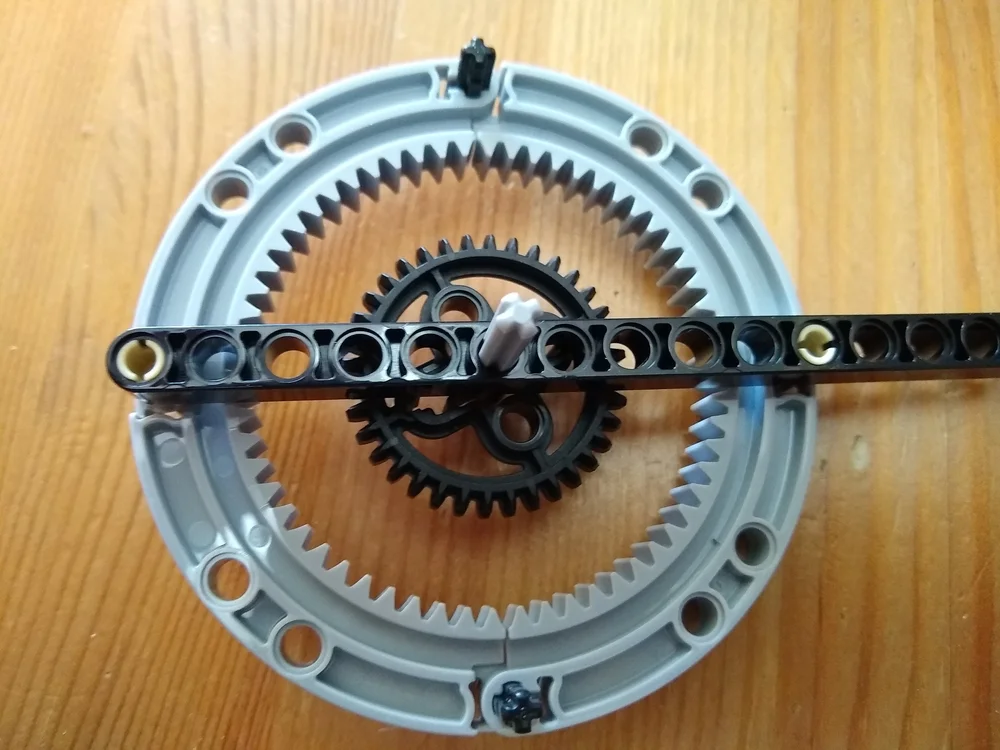
Ring and Sun Gear
The 15L beam overhangs like it does to make a handle in a functional build—this should likely be symmetrical especially if the ring gear is not held fixed.

Final Assembly of the 36/12 PGT
20/20
The 20/20 system is sort of a nightmare. This is not what my engineering professors would call an “elegant solution”. The issue is that the diameters of the 20 tooth gears are 3 studs. When three are placed in a row, the center to center distance for the two planets is 6 studs. Even numbers are great for system building… but not so much for Technic. To my knowledge (again limited Technic parts) there is no Technic “jumper plate” for working with even-numbered spacing.
I ultimately used piston crankshaft pieces to line up the two halves of the planet carrier and then had to add some System pieces to get a centerline shaft for the planet carrier. Also, the carrier uses 7L and 5L beams that will cause an imbalance, further making this design impractical for high-speed operation. I’m confident that there is likely a better solution out there. (Let me know if you see one in the comments!)
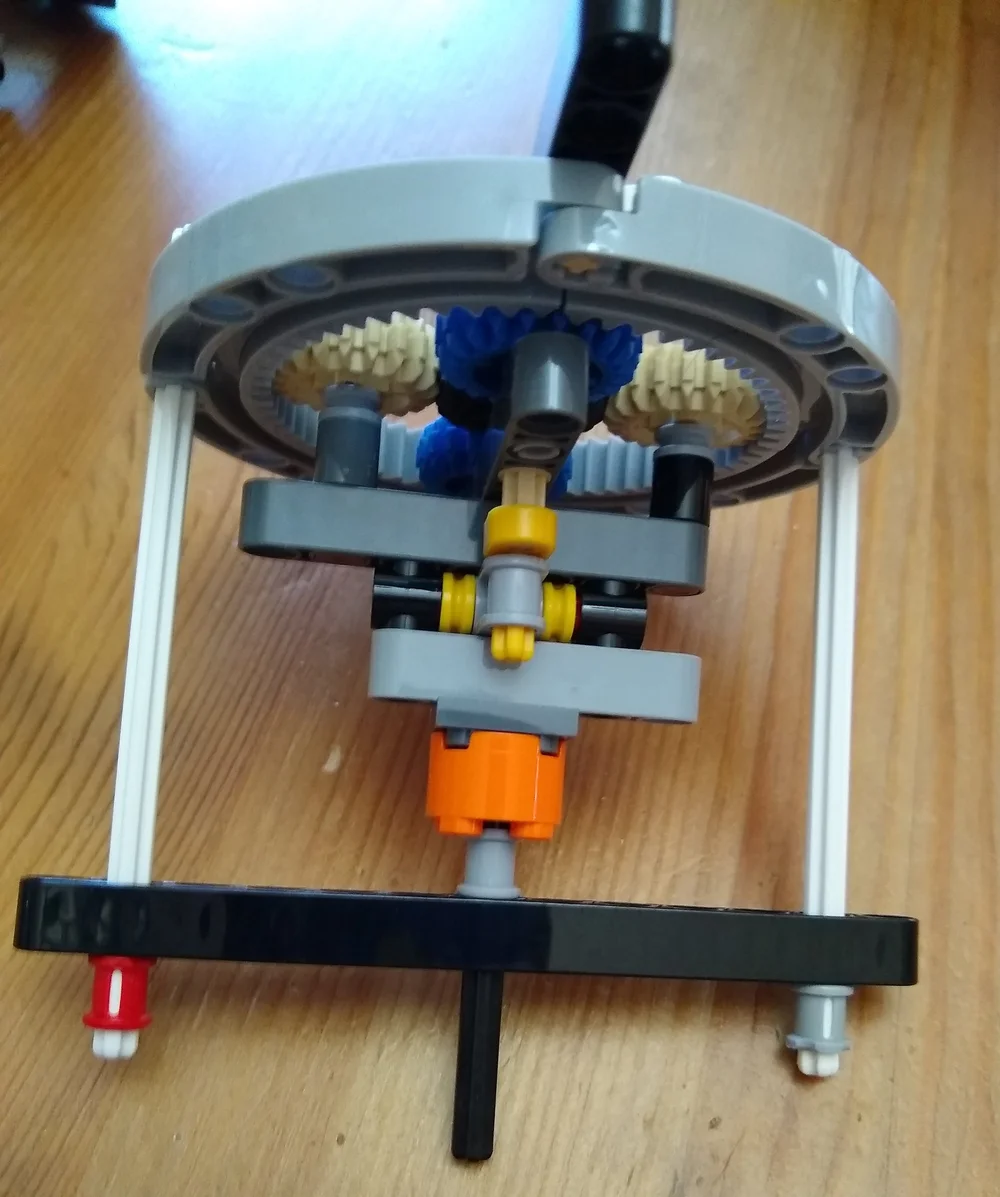
A hot mess of a planet carrier
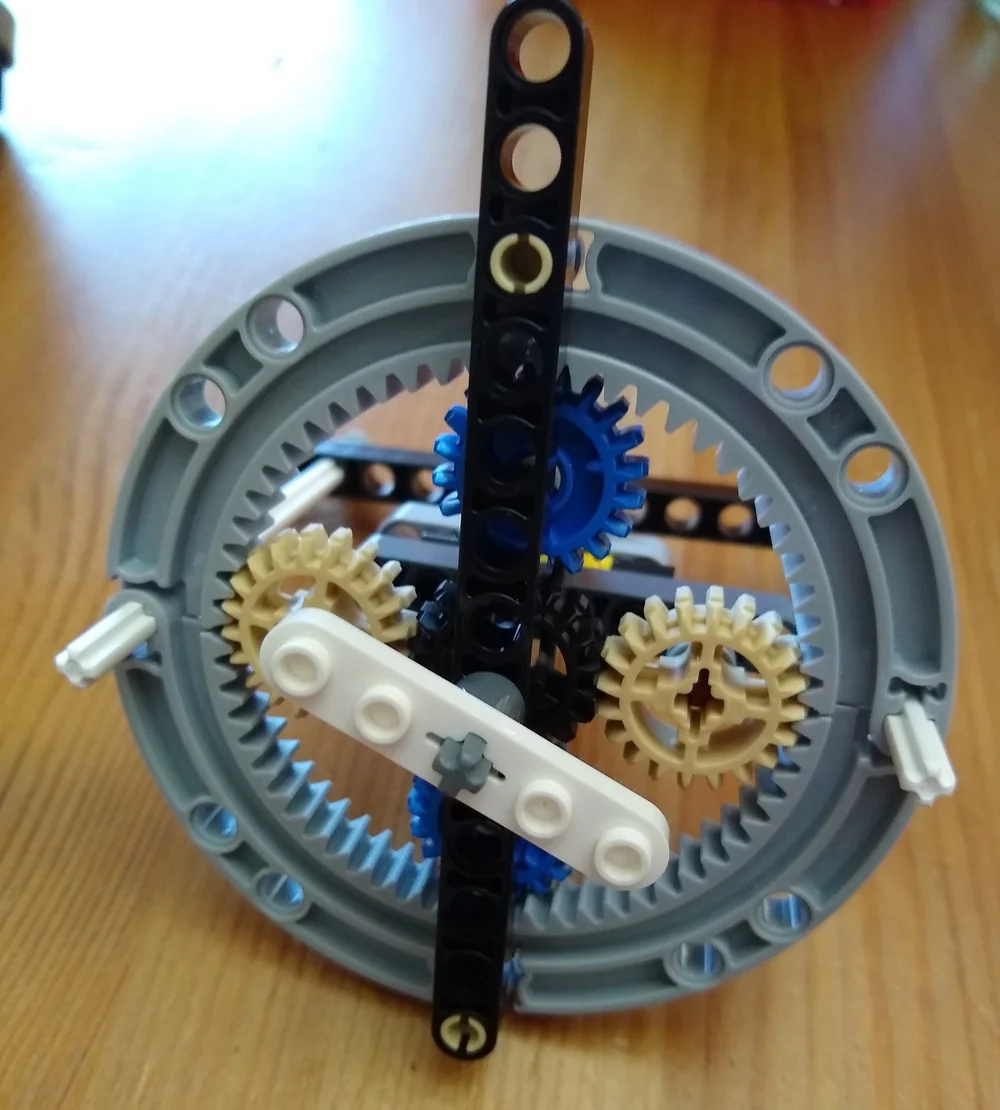
20 toothed assembly Sun gear side
More noodling led to retrying some of the straight tooth gears in a stepped planet design. A stepped planet is where the planet gears have two different profiles: one that interfaces with the sun gear and one with the ring gear. This opens up our gearing ratio options a little bit. We can now have a 40 toothed sun gear with an 8/12 toothed stepped planet or a 24 toothed sun gear with 16/20 toothed stepped planet. I modified the originals above and, thanks to the help of Mark H. in my LUG, improved on the planet carrier for the 6 wide center to center gear distances!
First the 40/(8/12)
This one was a pretty simple switch out which I’ll just present pictures for—basically, the 36/12 system above is increased in thickness to account for the addition of the 40 tooth sun gear and the 8 toothed upper planets.
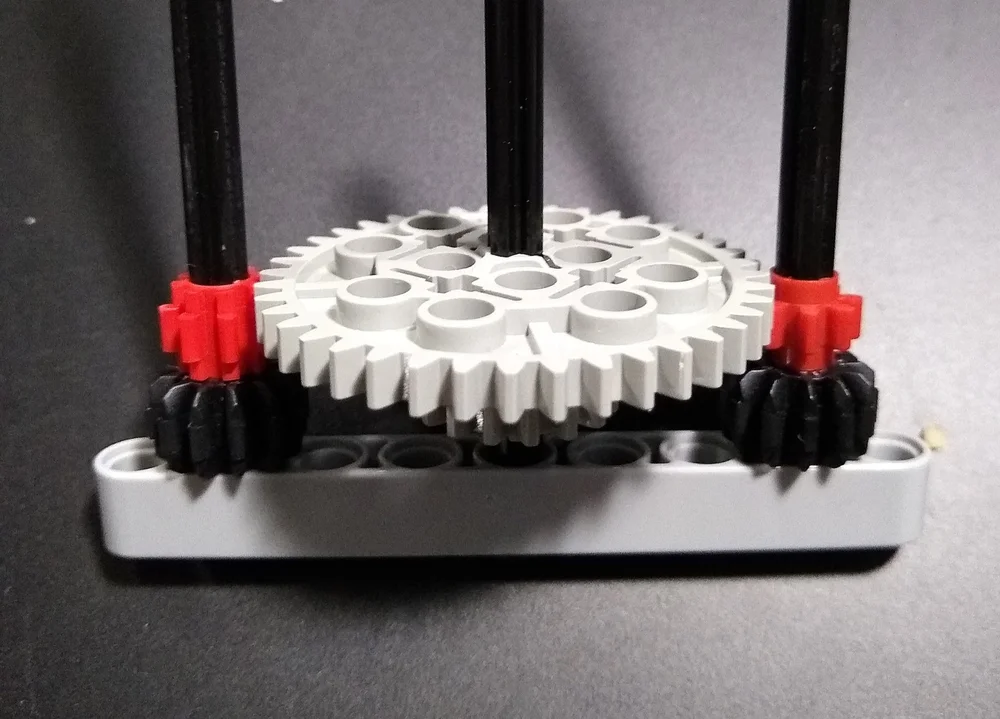
40 tooth sun gear to stepped 8/12 toothed planets
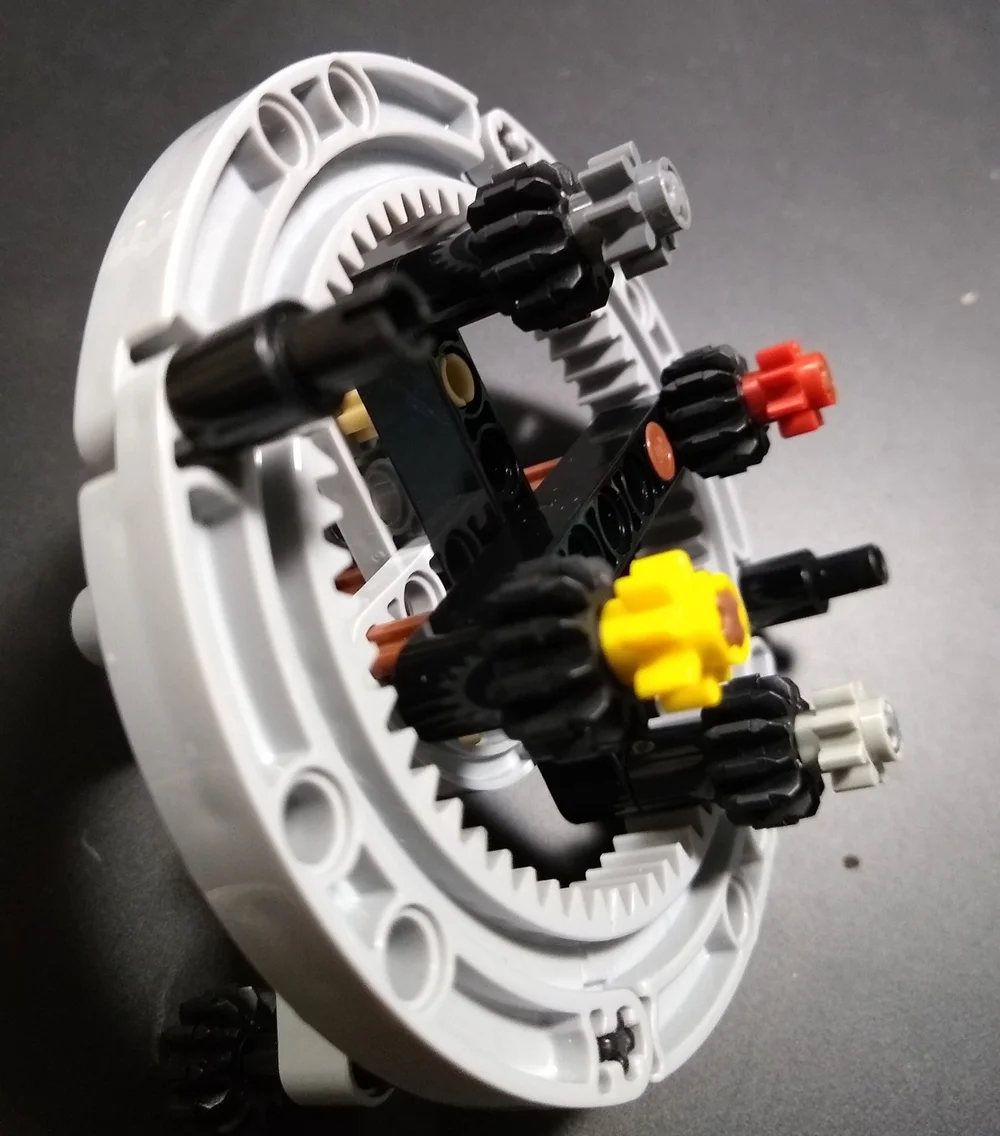
Inserting the planet carrier into the ring gear

Fully assembled 40 / (8/12) PGT
24/(16/20)
I could have hidden the hideous planet carrier above from you, but design refinement is an important engineering (and MOCing) process. I asked around for an idea to get the half-pin offset, and Mark H. in my LUG came through with the suggestion of using 1x2 bricks with 2 holes—combining this with a 1x2 brick with axle hole and some 1x6 plates, I was able to make a much more elegant planet carrier!
Now as it is built up of bricks and plates, it’s not going to be as robust as a full Technic solution but it removes the imbalances and several of the other issues of the above design. Details and photos of the new carrier and the full assembly are below.

24 tooth sun gear to stepped 16/20 toothed planets
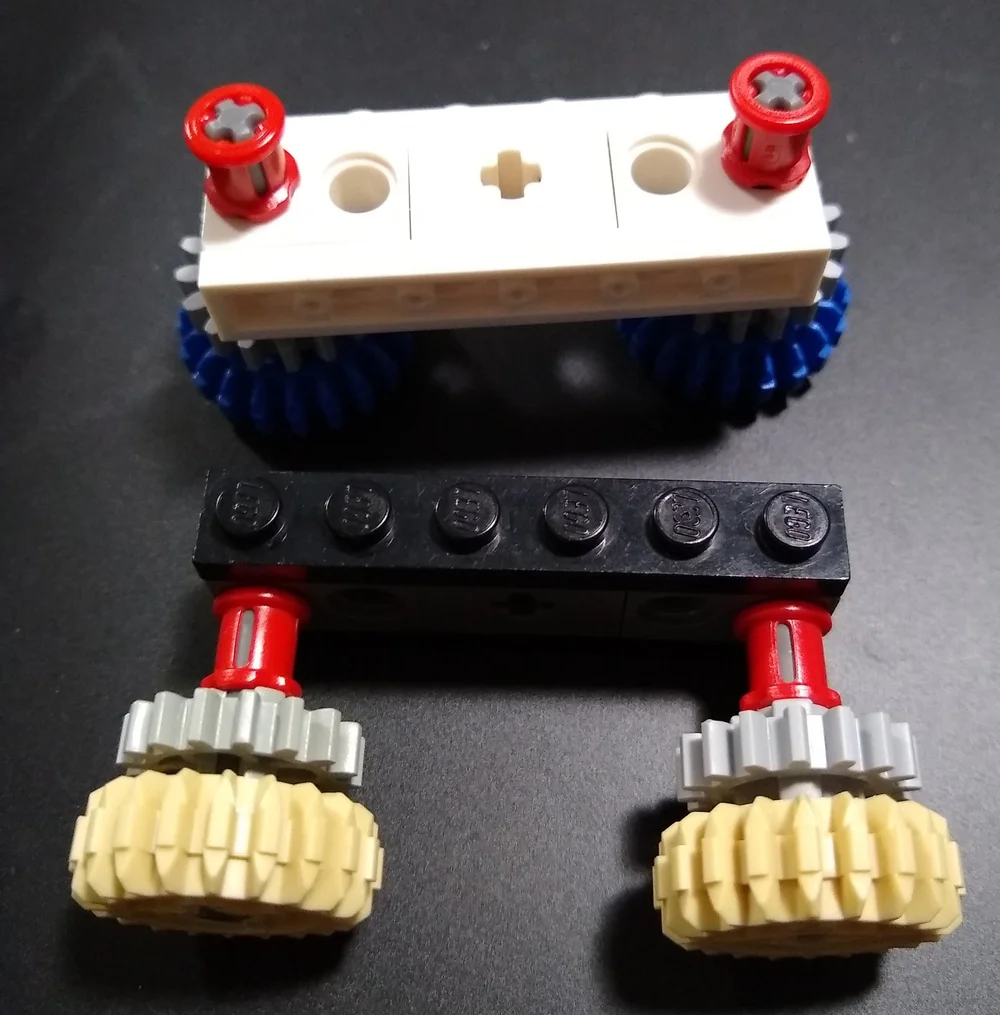
New and improved planet carrier!
The assembly of the full gear train with the stepped gears is a bit trickier and takes some patience as the sun gear is trapped between the planet carrier and the planet gears due to the larger diameter of the lower planets. The order that the gears are stacked could be reversed for easier assembly as well.
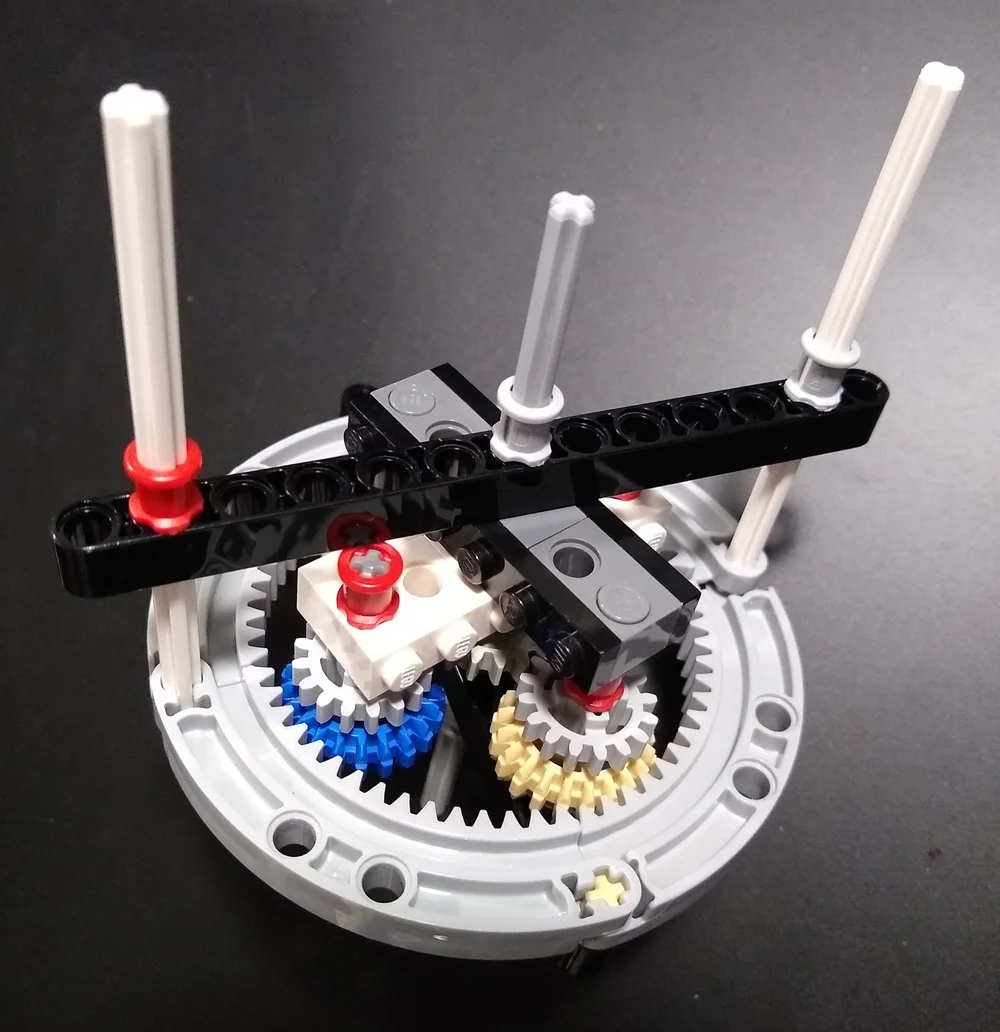
24 / (16/20) assembly ffrom the planet carrier side
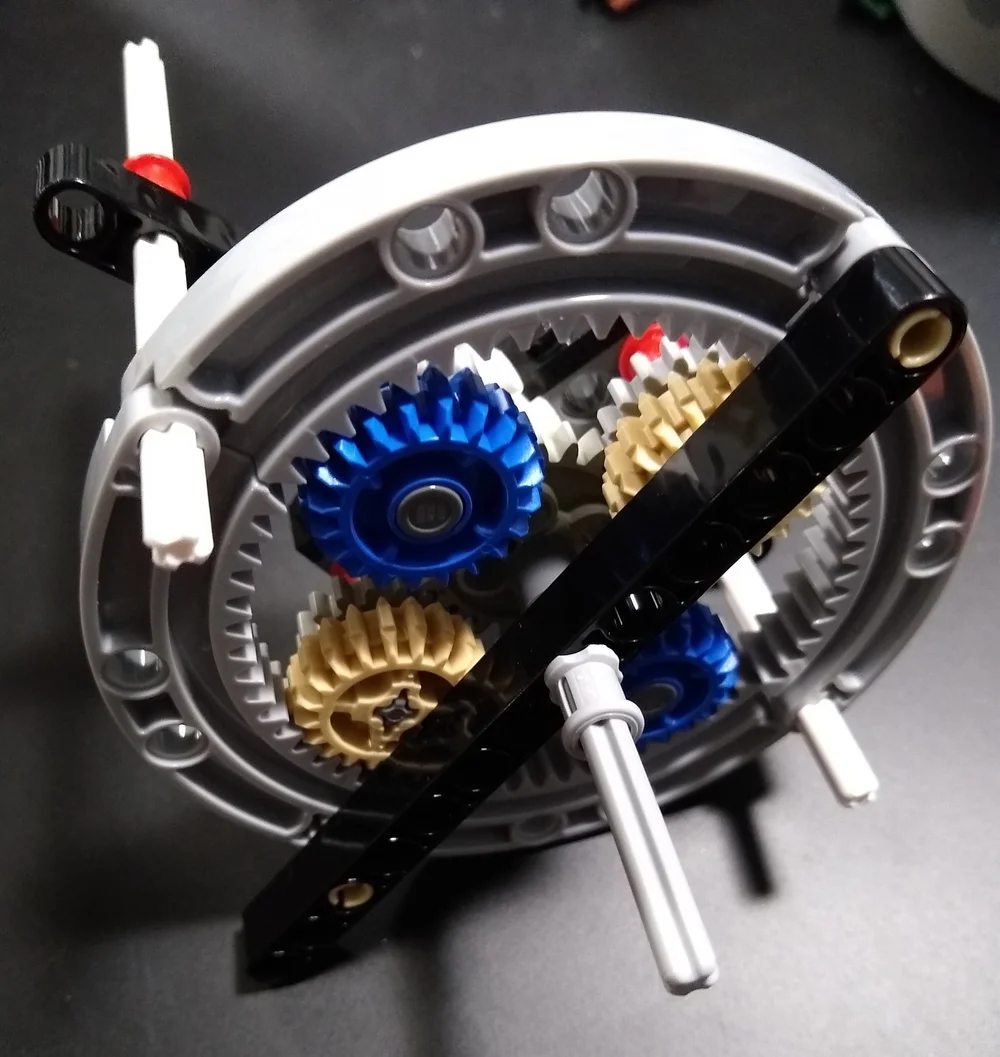
24 / (16/20) assembly—notice how the sun gear is captured behind the 20 toothed gears
Thoughts and Homework
Now you’ve learned all these ratios and how to build them, what should you use it for? As I alluded to above, all manner of things use planetary gear trains! My examples above are prototypes—I think the 36/12 and 40/(8/12) could possibly be made slightly shorter, and the original 20/20 design was improved in the 24/(16/20) design, but more refinement is likely possible.
Unfortunately for now development of MOCs using the Planetary Gear Trains will be left as an exercise for the reader. (I hated when that phrase was used in my engineering textbooks. I was more excited about developing the technique than applying it.) If I do use it in something or further refine it I will be sure to write another article! (You can see an example of a planetary gear in action in the video from KEN LEGO on YouTube below.)
I think these new LEGO gear racks offer a lot of potential, even beyond PGTs. I hope they show up in more sets so we can see what the LEGO design department comes up with and discover what all those talented Technic MOCers out there dream up!
If this article has interested you in engineering and you want to learn more, the Wikipedia article on epicyclic gearing is a great place to start.
Best of BrickNerd - Article originally published February 22, 2022.
What would you use a LEGO planetary gear train for? Or will you leave the math to others? Leave your thoughts in the comments below.
Do you want to help BrickNerd continue publishing articles like this one? Become a top patron like Charlie Stephens, Marc & Liz Puleo, Paige Mueller, Rob Klingberg from Brickstuff, John & Joshua Hanlon from Beyond the Brick, Megan Lum, Andy Price, Lukas Kurth from StoneWars, Wayne Tyler, LeAnna Taylor, Monica Innis, Dan Church, and Roxanne Baxter to show your support, get early access, exclusive swag and more.

